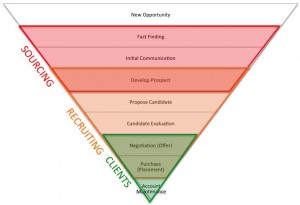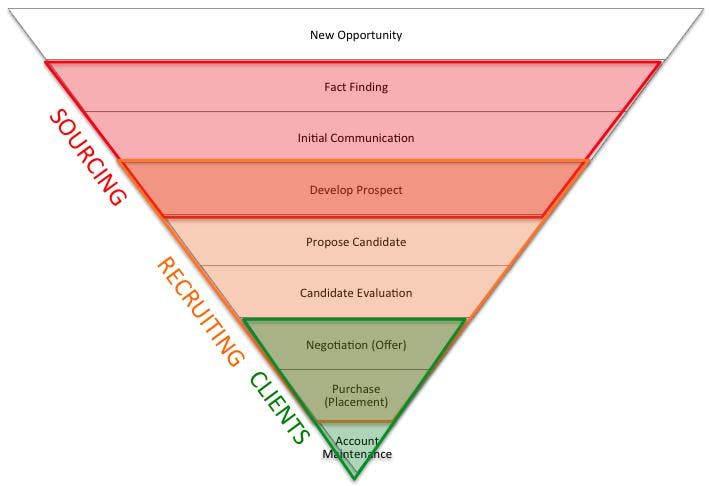The sales process is a step-by-step layout of what actions must be taken to turn prospects into customers. Regardless of how you look at it, recruiting is pretty much the same as product or service sales.
The only difference is that when talking to candidates, our ‘product’ is a job opportunity and our ‘customer’ is the prospect (who hopefully turns into a candidate). As such, we approach the sales cycle in much the same way: targeting prospects, selling them on feature/benefits, closing a deal, and (hopefully) follow-up and account maintenance.
If you look at it through a recruiting lens, substitute sourcing for all the pre-sales activities, recruiting for sales and closing, and HR for account management.
It’s really that simple.

Depending on who/what you reference, a sales funnel will typically look something like the illustration.
Just move a couple of these things around and – voila! – you’ve got a recruiting process funnel that includes sourcing, recruiting, and clients. The following is a basic breakdown of how this funnel can work – I encourage you to share this with your new recruiters as a reference to how the recruiting process works with all parties involved.
New Opportunity
This is when a new req is opened. Or, this could be when you start digging your heels into some marketing activities to develop new business. No matter how you look at it, this is the business development portion of your funnel, which, of course, makes it the widest part. Qualifying the ‘opportunities’ is a whole topic in and of itself that has been covered in the past and especially in The Fordyce Letter.
Sourcing
Fact Finding: In a sales funnel, Initial Communication comes before Fact Finding, but when you’re recruiting, it’s important to do some digging around first. We also call this competitive intel gathering or pre-research.
This is where dedicated sourcers can really shine — this step in the process can yield information that can be beneficial to your client in more ways than just for hiring purposes. For example, let’s say you’ve recently been given an assignment by your client to find several engineers to design an updated version of an existing product. You uncover some information that their biggest competitor has recently released a number of employees who were working on a product that would compete with theirs. Not only does this provide you with some excellent potential candidates, but it also gives you some knowledge about what’s going on at your client’s competitor — perhaps they are abandoning their product, or perhaps they are working on something new that your client should be aware of.
A good recruiter will share this information with his/her client because it benefits more than just the team that needs to hire engineers — and it also shows your client that you’re more than just a transactional recruiter.
Initial Communication: After a fun fact-finding mission, during which a good recruiter will discover additional information about prospects that can be used to ‘warm up’ the conversation, initial outreach is made.
There are many great articles on the art and science of cold-calling and initial prospect contact — the more you are able to relate to your prospect, chances are the more receptive they’ll be to taking your call and exploring your opportunity.
At this point, the more you discover during your fact-finding part of the process, the more success you can expect when doing initial outreach to your prospects.

Sourcing/Recruiting Handoff
Develop Prospect: Let’s substitute the word “solution” for “prospect” at this step in the funnel, because they are still not a viable candidate.
At this poin, the line between sourcing and recruiting can get a little blurry depending on how your team is set up. If you have dedicated sourcers, this can be a handoff point for you to flex your recruiting muscles. Sometimes, it is a sourcer’s responsibility to ‘develop’ a prospect — which means they must conduct pre-screens to determine if basic qualifications exist. Other times, sourcers lob those prospects who’ve indicated interest over to their recruiting counterparts to be screened for potential candidacy.
There is no right or wrong answer here — it depends on the structure of your organization and where you choose to draw the line.
Recruiting
Propose Candidate: Once prospect development has taken place and the prospect has been converted into a candidate, it is obviously the job of the recruiter to pitch the candidate to the client. How you choose to do this depends on whether or not you present candidates first, and then do more in-depth evaluation based on the response of your client, or whether you take care of complete screening prior to making an initial proposal.
Candidate Evaluation: At this stage, you can switch around Candidate Evaluation and Propose Candidate depending on how you work with your clients. Some recruiters like to pre-pitch candidates to clients to share some highlights of the individual and determine if there is interest prior to digging deeper into the evaluation/interviewing process. Other recruiters like to conduct these interviews before sending a candidate to the client.
Again, there is no one correct answer here – it all depends on how you’ve chosen to structure your team.
Recruiting/Client Handoff
Negotiation (Offer): While recruiting is fully responsible for getting both the candidate and the client to this stage, it’s time for the client to step in and become more involved in the process.
If the recruiter has done his/her job up to this point, there should be no haggling between the candidate and the client over compensation, benefits, and so forth, as that is the recruiter’s job to handle the details, and be the go-between.
With recruiting and sourcing partnering up early in the process (at the development phase), and recruiting continually “checking in” with candidates regarding the opportunity, handling objections along the way, the majority of candidates reaching this stage should be ready, and willing to accept.
Purchase (Placement) and Account Maintenance
These two stages in the funnel should be predominantly be handled by the client, though the recruiter should be involved with the actual hire itself, and should continue to check in with both the client and the candidate well after the hire is made. After all, new hires are excited about their new opportunity and likely grateful to the recruiter for presenting the opportunity to them. They can be an incredible source of referrals for you for other clients and opportunities.
Conclusions
No part of the funnel is more important than the other: While this recruiting process funnel provides a great visualization of who is responsible for what and where, remember that every single component is important for the successful functioning of the organization as a whole. Without sourcing, there would be no prospects to recruit. Without recruiting, there would be no placements to be made. And without clients, there would be no business to begin with. Each part is essential for the success of the business as a whole.
Duties are separated, but it takes teamwork to make a hire: When deciding how to best work together with all parties involved, consider this as well as the sales funnel when dividing out functions. By working together as a team and not saying, “That’s not my job!” you will have more success in bringing the best people to your clients and therefore making more placements with them. They’ll see how well you work your process and think, “I want to continue doing business with a company that works so well together!”
I hope this proves to be a simple yet easily applicable visual aid for your new recruiters to use. Happy hunting!
